- Lesson One: The Number One
- ... in Geometry
- ... in Nature
- ... in Culture
- "Uroboros" (related artwork by the author)
- "Creation" (related artwork by the author)
- Lesson Two: The Square Root of Two
- ... in Geometry
- ... in Nature, Part 1
- ... in Nature, Part 2
- ... in Culture, Part 1
- ... in Culture, Part 2
- "Duality" (related artwork by the author)
- Lesson Three: The Square Root of Three
- ... in Geometry
- ... in Nature
- ... in Culture
- "Vesica" (related artwork by the author)
- Lesson Four: Phi, or the Golden Proportion
- ... Intro, Part 2
- ... Intro, Part 3
- ... in Geometry
- ... in Nature
- ... in Nature, Part 2
- ... in Culture
- "The Flower of Phi" (related artwork by the author)
- Lesson Five: The Five Perfect Solids
- ... Intro, Part 2
- ... The Tetrahedron
- ... The Octahedron
- ... The Cube
- ... The Icosahedron
- ... The Dodecahedron
The square root of three is geometrically generated by two separate, yet related, figures - the perfect cube, and a shape known as the Vesica Piscis. To gain an understanding of this number and its inherent meaning, let's start with the perfect cube.
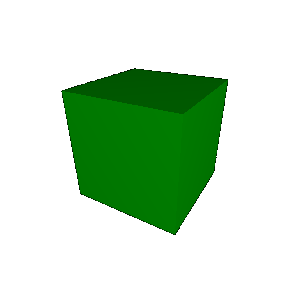 Original artwork created by A. O'Connor for Nature's Word using POV-Ray and Adobe Photoshop 5.0.
Original artwork created by A. O'Connor for Nature's Word using POV-Ray and Adobe Photoshop 5.0.The cube is, as noted in Chapter One, an excellent representative of the inherent unity of all things. This is due to the fact that it measures one in all ways - every edge equals one, as does the volume of the space defined by the cube (length times width times height equals volume, in this case 1x1x1=1).
The square root of three is generated by this three-dimensional object in much the same way that the square root of two is generated by the two-dimensional square. In the instance of the square root of two, the line in question is generated by connecting opposite corners, and so it is with the square root of three. By connecting the most opposing points across the volume of the cube, we create a line that measures 1.732..., or the square root of three.
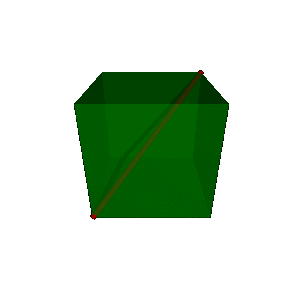 Original artwork created by A. O'Connor for Nature's Word using POV-Ray and Adobe Photoshop 5.0.
Original artwork created by A. O'Connor for Nature's Word using POV-Ray and Adobe Photoshop 5.0.The inference generated by this idea is very similar to that of the square root of two - opposites have been defined within unity and in relation to one another. The fundamental difference between the square roots of two and three is that with the example of the square root of two we were making a relation on a two-dimensional plane - a flat, pre-manifestation level, with the term "manifestation" here referring to actual creation in the three-dimensional physical world. But, in the case of the square root of three, we are crossing a three-dimensional gap, connecting not only opposite points on a two-dimensional level, but also joining opposing planes - i.e. the top and bottom, left and right, and front and rear sides of the cube. The implication is of the joining of a double-duality, if you will.
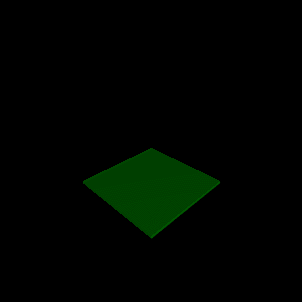 Original animation created by A. O'Connor for Nature's Word using POV-Ray, Adobe Photoshop 5.0, and WWW Gif Animator.
Original animation created by A. O'Connor for Nature's Word using POV-Ray, Adobe Photoshop 5.0, and WWW Gif Animator.Another extremely important aspect of the square root of three line is depicted in the animation at left. At the beginning of the animation, we see a perfect square laid on a horizontal plane, representing, as always, unity. By creating a perfect two-dimensional square, we are implying unity, but that unity is not representational of the actual manifested universe, which we all know exists in three dimensions. Because of this fact, we can say that a two dimensional square represents pre-manifestational unity. This pre-manifestational unity has taken a fundamental step from the original state of self-contained unity, which is represented by a point or sphere. The step that differentiates the pre-manifestational state from the self-containted state is the presence of duality within unity, which is implied by the square root of two as discussed in the last chapter.
In order to take the next exponential leap forward, however, something much greater is needed. That step is the leap from two dimensions to three. In every step and complexification of unity, it must by its very nature remain a unity. It is here that our square root of three line comes into play. If we measure upwards from any one of the corners on our two dimensional square a distance equal to one of the square's sides (effectively equal to 1 - the blue line in the animation), and then connect the top of this line back down across the square to the corner opposite it (the red line in the animation), then that new line equals 1.732..., or the square root of three.
By finding this new corner point above each corner of the plane of the original square, we automatically imply an identical square on the new plane whose location we have just determined. In the animation, we see that after all four corner points have been triangulated by using the square root of three lines, a new prefect square on a higher plane is defined. If we examine this image, it is clear that we have effectively projected duality into three dimensions, by creating and "upper" and "lower" realm. Our unity is still present, however, if we simply connect adjacent corners from upper plane to lower - thus creating a perfect cube, measuring one on all sides and in volume.
It is by this example that we see the fundamental creative aspect of the square root of three line. Once unity takes its first step into actual three dimensional existence, the square root of three simultaneously comes into existence. The creation of three dimensionality cannot be said to be caused by the square root of three, and the square root of three cannot be said to be created by three-dimensionality - both imply one another perfectly, simultaneously, and automatically.
Let us turn our attentions now to the very special oval shape known as the "Vesica Piscis." To begin with, the term "Vesica Piscis" is a Latin term, translating to "Fish Bladder," or more accurately, "Fish-like Bladder." The reason behind this name becomes clear when we find out how the Vesica is generated.
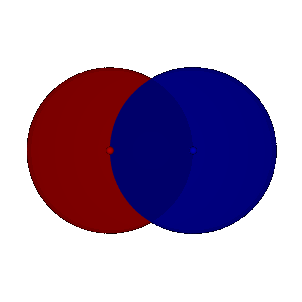 Original artwork created by A. O'Connor for Nature's Word using POV-Ray and Adobe Photoshop 5.0.
Original artwork created by A. O'Connor for Nature's Word using POV-Ray and Adobe Photoshop 5.0.If we take two perfect and similar circles (effectively two unity's), and overlap them so that their circumferences cross exactly through the center points of one another, an oval shape is created by the space which is shared by the two circles. This oval shape is our Vesica Piscis. The oval shape is similar to a side view of the body of a fish (without fins or tail), which is how this shape obtained its name.
If we assume that the radius of each of the circles is equal to one (the yellow line in the image), then the line that connects the top and bottom points in our oval shape is equal to the square root of three (the purple line in the image). Once again, this is apparently a very simple operation, but one that has complex implications. Let's think a little bit more about the implied symbolism of this shape, and take apart why exactly it describes the creative process in the same way that the cube does in our example above.
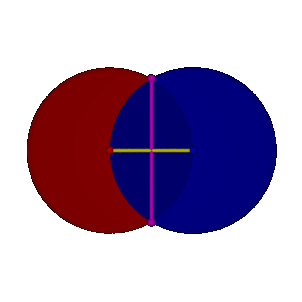 Original artwork created by A. O'Connor for Nature's Word using POV-Ray and Adobe Photoshop 5.0.
Original artwork created by A. O'Connor for Nature's Word using POV-Ray and Adobe Photoshop 5.0.As stated, we are taking two unity's and crossing them over one another in such a way that there is a perfect balance between them. Because we have two circles, and only two, it is safe to assume that they represent a basic duality, in much the same way that our two squares on parrellel planes in the example above could be taken to represent "upper" versus "lower" realms. To illustrate this point more clearly, let's consider the color aspect of our image - color being such a handy example when dealing with the idea of a duality. One circle is filled with red, and the other with blue Where the two opposing cross in the center they mix together half and half, to create something completely new - namely purple.
Obviously, purple is not red or blue - it is a completely new entity which stands separate from the two halves that have been joined to create it. Because our circles are overlapping one another in perfect balance, neither half of the duality is dominating the other - they are being brought together in perfect balance, and the result is something completely new, and heretofore unknown in the realm of our example. If we reconsider the prior example of how the square root of three is generated from the cube, we will remember that it is generated by joining the opposing corners (the two opposites representing duality) with a line, i.e., making the relation between the two. In the example of the cube, it is the two corners that represent our red and blue characteristics, and the line that stretches between them that would be our purple, "shared" portion. Here we find the exact same idea - creativity - but represented with a different geometric figure. "Coincidentally" that figure just happens to imply the square root of three as well.
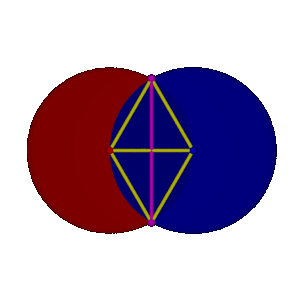 Original artwork created by A. O'Connor for Nature's Word using POV-Ray and Adobe Photoshop 5.0.
Original artwork created by A. O'Connor for Nature's Word using POV-Ray and Adobe Photoshop 5.0.Another interesting "coincidence" that occurs when we generate the Vesica Piscis is that it automatically implies perfect equilateral triangles as well. There are a few ways to create the equilateral triangle from the vesica piscis - the first is by simply connecting the center points of the two circles to one another and connecting these same points to the top (or bottom) point of the Vesica (yellow lines in the image). Note that two equilateral triangles are immediately implied when the vesica is created, one pointing upwards, and the other down.
It can be seen quite clearly in the illustration that the purple line that cuts from the apex of the lower triangle to the apex of the upper triangle is divided in half by the shared yellow line that forms that base of both triangles. This means that the height of any equilateral triangle is always the length of the triangle's side times one half of the square root of three - a formula that often comes in handy when working with equilateral triangles.
In an equilateral triangle:
height = edge length x 1/2 of the square root of three
The equilateral triangle has often been used as a symbol for movement towards an ideal. As an example, the upward pointing triangle has been used to represent the element fire in various western traditions, whereas the downward pointing triangle represents water - fire being here understood as the active force (hot, dry, radiant, etc.) and water as the passive force (cool, wet, contractive, etc.). The six pointed star, known to Judaism as the Star of David, but known the world over, is created by conjoing the two opposing forces represented by the two equilateral traingles. As such it is interpreted as a sign representing perfect balance - balance between duality. If we take this same idea to the vesica, we once again find two opposing equilateral triangles that are in a state of balance - this time tied together and placed in a state of total equilibrium by the single line that forms their mutual base. Again, we find an apt expression of balance of opposing forces within the vesica.
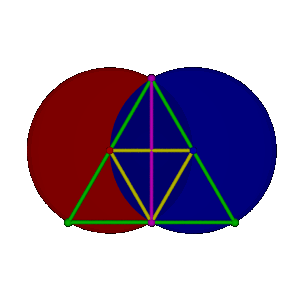 Original artwork created by A. O'Connor for Nature's Word using POV-Ray and Adobe Photoshop 5.0.
Original artwork created by A. O'Connor for Nature's Word using POV-Ray and Adobe Photoshop 5.0.The second method used to create equilateral triangles from the vesica is to extend the edges of the triangles that we have just described until they touch the outer circumference of both circles, and then to add a line connecting these points to form the base of the triangle (green lines in the image). Notice that the base line cuts directly through the lower point of the vesica, and the apex of the triangle is located at the upper most point of the vesica.
If we extend all of the sides of our original two yellow triangles, we find that they quite directly define two perfect hexagons that share the two triangles within the confines of the vesica. We can deduce quite directly from the image that it is the nature of a perfect hexagon that every side and every line radiating from center point to the six corner points measure the exact same length. In other words, every "pie piece" of a perfect hexagon is an equilateral triangle.
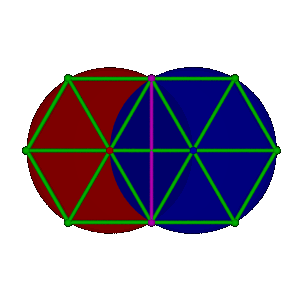 Original artwork created by A. O'Connor for Nature's Word using POV-Ray and Adobe Photoshop 5.0.
Original artwork created by A. O'Connor for Nature's Word using POV-Ray and Adobe Photoshop 5.0.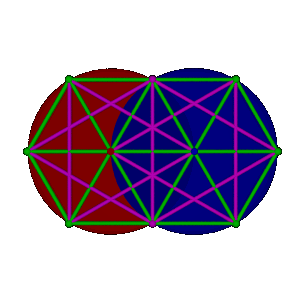 Original artwork created by A. O'Connor for Nature's Word using POV-Ray and Adobe Photoshop 5.0.
Original artwork created by A. O'Connor for Nature's Word using POV-Ray and Adobe Photoshop 5.0.The connections continue, but we will leave the reader at this point to pick up compass and straightedge to discover these on their own.
It is important to note before moving on the ease with which one can create an equilateral triangle using the vesica piscis. As stated above, in order for the proportion between the horizontal and vertical axes of the vesica to equal one to the square root of three, we must assume that the radius of the two circles are equal to one. Continuing with that assumption, it is clear that each side of the triangle also must equal one, as each one of the sides is nothing other than a radius of one of the circles.
When it is considered that the Trinity takes a major role in nearly every ancient mythology and religion spanning the globe, then it becomes clear why the use of equilateral triangles were used intrinsically in the artwork and architecture of many cultures. If we pay heed to the writings of Sydney Klein, the ancients found that it was nothing short of miraculous that a perfect equilateral triangle could be generated by simply overlapping two perfect circles through one another's center points. Indeed, who can say that it is not a highly convienient "coincidence" when attempting to create sacred artwork that all one need do is start by overlapping two unity's (circles), and from there simply "connecting the dots," never having to measure or refer to any point that is not automatically implied by the overlapping of the circles? The resulting geometric grid is totally self-referencing, and automatically implies the square root of three and it's related proportions intrisically - not to mention that structures based upon this grid have maximal structural integrity for the amount of materials used.


